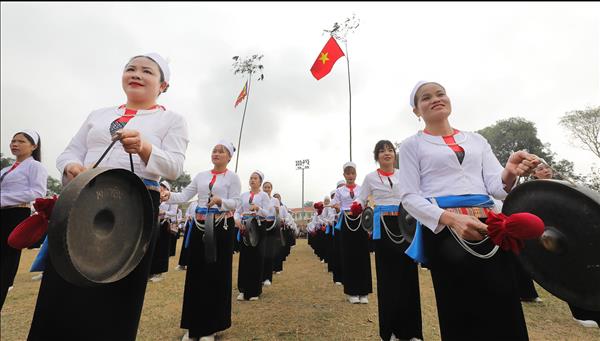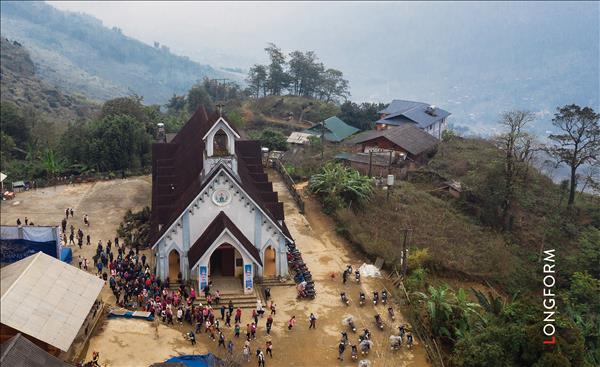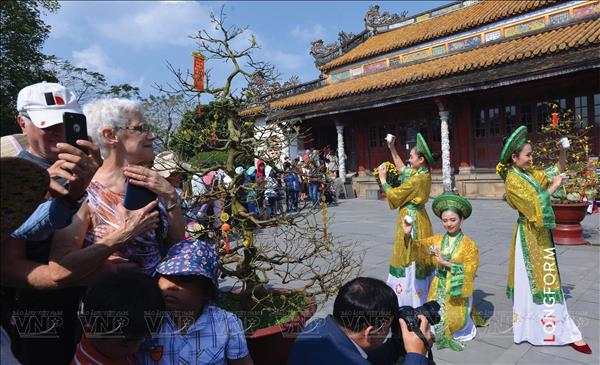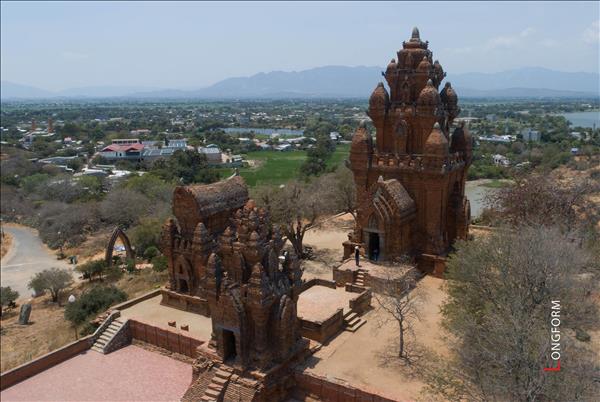Former royal rituals
Visiting the Hue Imperial Relic Site in Lunar New Year 2018, one could see extraordinary royal rituals which can only be read about in history books, such as Le thuong tieu (Tet pole-erecting ceremony), Le doi gac (guard change ceremony), patrol over the Purple Forbidden City by the imperial guard, imperial court music and dances and royal games.
“During the Nguyen dynasty, royal rituals before and after the Lunar New Year Festival (Tet) were held formally, many of which were conducted by the king himself”, said Phan Thanh Hai, Director of the Hue Monuments Conservation Centre.
Historical notes show that during the Nguyen dynasty, Tet lasted 12 days from the 25th of the last lunar month of the old year to the 7th of the first lunar month.
During the holidays, the king held ceremonies within the Purple Forbidden City, including Le thuong tieu on the 23rd or 30th of the last lunar month, and ceremonies to give Tet wishes to the king and the queen mother on the first and second days of the lunar new year. The king himself also hosted a ritual to offer incense to ancestors at Thai Mieu and The Mieu temples, and a ceremony to give lucky money to royal members, mandarins and guards.
On the third day of the lunar new year, the king visited his teachers while on the fifth day, he went to pagodas and royal tombs outside the citadel. On the seventh day, a ceremony to take down the Tet pole was held to close the Tet holidays. The royal seal opening ceremony and a parade of the imperial guard were held on the same day to start work in the New Year.
The restoration of royal rituals gave visitors a chance to experience and explore the life inside the palace of the Nguyen kings, which remained mysterious to their subjects.
Pastimes for leisure in the imperial palace
Spring was regarded as the season of holidays. This was no exception for the court where royal games were played during Tet, including xam huong, bai vu, dau ho and a calligraphy show.
Playing xam huong (pink cards) is to throw dice so that players can take slabs carved with red Chinese characters corresponding to degrees of a former examination system, which were Bachelor, Master, Doctor, the First doctoral laureate of the Metropolitan Examination and the Third, Second and First doctoral laureates of the first rank of the Royal Examination.
A set of slabs for the Xam huong game consists of 63 slabs divided into 6 types for 32 scores each. The total scores of all slabs is 192. At the end of the game, the winner will be the one who gets the highest number of the total numbers of the slabs.
This game, which was not only for entertainment but promoted learning, first was played in the court but later became a popular game during Tet. Many old people in Hue still play the game.
Bai vu was a folk game of much interest for royal ladies under the Nguyen dynasty, often played during the full moon night or on the first days of the year for receiving good luck.
A set of bai vu includes a medium table with images of eight animals; a porcelain plate and a porcelain bowl for revolving the fizgig that is a cube added with two sharp sticks. On each of the eight surfaces of the cube, there is the image of an animal. In bai vu, players put money on their selected animals on the table. Then, the game-master turns the fizgig on the plate, and then puts the bowl upside-down when the fizgig is still moving in the plate. The players may put more money or move money to other animals. After the players finish putting money on their selected animal, and the fizgig stops revolving, the game-master pulls the bowl out and announces the animal on the front surface. Those who put money on that animal are the winners. It is regulated that the participant puts money on one animal, but gets money six times higher.
Dau ho (throwing darts at a vase), a game originating from China, was exclusively played by kings and mandarins of the Nguyen dynasty. A set of dau ho includes vases, darts and a small wooden deck (also called a horse). In the game, players throw a small wooden or bamboo dart which is supposed to land on the wooden deck, bounce toward a vase, designed to look like a small bottle of wine with a small bottle-neck, and drop into the vase’s mouth. Nowadays it is too difficult to play with this plate so the player can throw the dart directly into the vase's mouth. This game challenges the player's skillfulness. Kings Tu Duc and Bao Dai were said to be experts at this game.
These royal games, once only played by royal families, were restored by the Hue Monuments Conservation Centre and are now luring local and foreign visitors to the Hue imperial relic site./.
“During the Nguyen dynasty, royal rituals before and after the Lunar New Year Festival (Tet) were held formally, many of which were conducted by the king himself”, said Phan Thanh Hai, Director of the Hue Monuments Conservation Centre.
|
Leading the Tet pole-erecting team are two men as the mandarins carrying the royal seals of the Nguyen dynasty. Photo: Thanh Hoa / VNP Ten men acting as the imperial guards carry the Tet pole which is a long bamboo tree with branches and leaves. Photo: Thanh Hoa / VNP A similar Tet pole-erecting ceremony is held at Long An temple along with the one at The Mieu temple. Photo: Thanh Hoa / VNP The imperial guard at Ngo Mon gate. Photo: Thanh Hoa / VNP. The imperial guard led by a mandarin march to the Purple Forbidden City through Ngo Mon gate. Photo: Thanh Hoa / VNP Trinh tuong tap khanh (gathering all the best wishes for the king), a court dance with four dancers representing the four deities from Heaven going to earth to convey wishes to the king. Photo: Thanh Hoa / VNP A royal bandsman. Photo: Thanh Hoa / VNP A cup dance, one of Hue’s traditional dances. Photo: Thanh Hoa / VNP |
| The Nguyen dynasty was Vietnam’s last feudal regime, which existed from 1802 to 1945 with the reign of 13 kings. This regime left five UNESCO-recognised heritages, namely the Complex of Hue Monuments (1993), Hue royal court music (2003), Wood-blocks of the Nguyen dynasty (2009), Imperial Archives of the Nguyen dynasty (2014) and Literature on Hue Royal Architecture (2016). |
During the holidays, the king held ceremonies within the Purple Forbidden City, including Le thuong tieu on the 23rd or 30th of the last lunar month, and ceremonies to give Tet wishes to the king and the queen mother on the first and second days of the lunar new year. The king himself also hosted a ritual to offer incense to ancestors at Thai Mieu and The Mieu temples, and a ceremony to give lucky money to royal members, mandarins and guards.
On the third day of the lunar new year, the king visited his teachers while on the fifth day, he went to pagodas and royal tombs outside the citadel. On the seventh day, a ceremony to take down the Tet pole was held to close the Tet holidays. The royal seal opening ceremony and a parade of the imperial guard were held on the same day to start work in the New Year.
The restoration of royal rituals gave visitors a chance to experience and explore the life inside the palace of the Nguyen kings, which remained mysterious to their subjects.
| The Hue Imperial City is a remarkable site in the Complex of Hue Monuments world heritage. It was the key work in protecting the Purple Forbidden City and Nguyen family temples. From the Imperial City, the picture of royal life was formed with numerous interesting and thrilling tales and secrets about the Nguyen dynasty. |
Pastimes for leisure in the imperial palace
Spring was regarded as the season of holidays. This was no exception for the court where royal games were played during Tet, including xam huong, bai vu, dau ho and a calligraphy show.
Playing xam huong (pink cards) is to throw dice so that players can take slabs carved with red Chinese characters corresponding to degrees of a former examination system, which were Bachelor, Master, Doctor, the First doctoral laureate of the Metropolitan Examination and the Third, Second and First doctoral laureates of the first rank of the Royal Examination.
A set of slabs for the Xam huong game consists of 63 slabs divided into 6 types for 32 scores each. The total scores of all slabs is 192. At the end of the game, the winner will be the one who gets the highest number of the total numbers of the slabs.
|
Inside the imperial city of Hue on a 2018 Tet day. Photo: Thanh Hoa / VNP Dau ho was the favorite royal game in the Nguyen dynasty. Kings Tu Duc and Bao Dai are said to have been experts at this game. Photo: Thanh Hoa Foreign visitors are curious about bai vu played by children. Photo: Thanh Hoa / VNP Visitors try xam huong, a game played by imperial maids during Tet. Photo: Thanh Hoa / VNP Visitors who win at royal games are awarded words done in calligraphy. Photo: Thanh Hoa / VNP A dragon and lion dance to welcome the New Year. Photo: Thanh Hoa / VNP A dragon and lion dance at Can Chanh Palace in the Purple Forbidden City. Photo: Thanh Hoa / VNP Foreign visitors enjoy watching goldfish in Thai Dich Lake inside the imperial city of Hue. Photo: Thanh Hoa / VNP The serene beauty of the former palace. Photo: Thanh Hoa / VNP |
| According to the Hue Monuments Conservation Centre, the Complex of Hue Monuments received a record number of over 3 million visitors in 2017. On the first three day of lunar New Year 2018 alone, more than 30,000 visitors came to the Hue Imperial City. |
This game, which was not only for entertainment but promoted learning, first was played in the court but later became a popular game during Tet. Many old people in Hue still play the game.
Bai vu was a folk game of much interest for royal ladies under the Nguyen dynasty, often played during the full moon night or on the first days of the year for receiving good luck.
A set of bai vu includes a medium table with images of eight animals; a porcelain plate and a porcelain bowl for revolving the fizgig that is a cube added with two sharp sticks. On each of the eight surfaces of the cube, there is the image of an animal. In bai vu, players put money on their selected animals on the table. Then, the game-master turns the fizgig on the plate, and then puts the bowl upside-down when the fizgig is still moving in the plate. The players may put more money or move money to other animals. After the players finish putting money on their selected animal, and the fizgig stops revolving, the game-master pulls the bowl out and announces the animal on the front surface. Those who put money on that animal are the winners. It is regulated that the participant puts money on one animal, but gets money six times higher.
Dau ho (throwing darts at a vase), a game originating from China, was exclusively played by kings and mandarins of the Nguyen dynasty. A set of dau ho includes vases, darts and a small wooden deck (also called a horse). In the game, players throw a small wooden or bamboo dart which is supposed to land on the wooden deck, bounce toward a vase, designed to look like a small bottle of wine with a small bottle-neck, and drop into the vase’s mouth. Nowadays it is too difficult to play with this plate so the player can throw the dart directly into the vase's mouth. This game challenges the player's skillfulness. Kings Tu Duc and Bao Dai were said to be experts at this game.
These royal games, once only played by royal families, were restored by the Hue Monuments Conservation Centre and are now luring local and foreign visitors to the Hue imperial relic site./.
By Thanh Hoa







